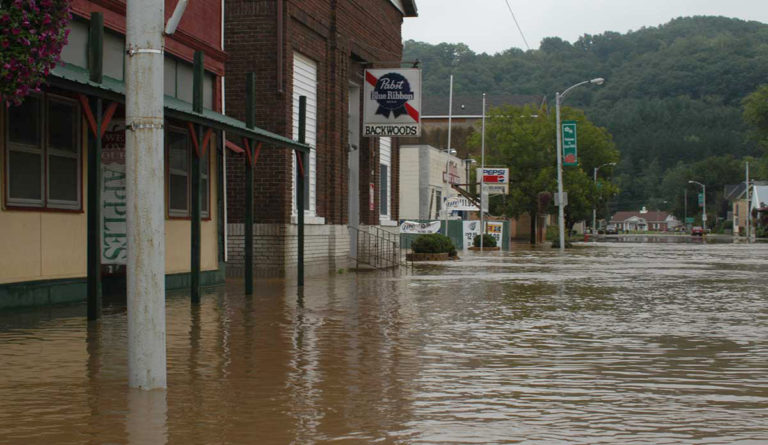Climate and Health: Adapting at the Local Level
Facing warmer and wetter state weather, the Wisconsin Department of Health Services developed a model to address public health impacts of extreme weather and changing climate at the local level.

Read Time: 6 minutes
Published:
Extreme weather events are becoming more common as climate trends shift across the globe. In Wisconsin, we’re seeing warmer and wetter weather. Extreme weather events and changing climate trends create health risks that we as public health professionals must be prepared to address. For example, extreme heat events cause heat-related deaths among vulnerable populations; extreme precipitation events can cause gastrointestinal illness from ground water contamination; longer summers increase the pollen season effecting the health of those with asthma and allergies; and warmer seasons can increase the geographic distribution of ticks and mosquitos as well as increase the transmission for vector-borne diseases including Lyme disease and West Nile Virus. Because extreme weather events happen at the local level and affect communities differently, the public health impacts of these extreme weather events and changing climate trends are best addressed at the local level.
What is being done about it?
The Wisconsin Department of Health Services (WI DHS) understands and appreciates the importance of addressing emerging climate-related health impacts. In order to best do this, the WI DHS received funding from the Centers for Disease Control and Prevention (CDC) to manage and implement a grant called Building Resilience Against Climate Effects (BRACE) to address the health impacts of climate effects in Wisconsin. This grant opportunity allowed the WI DHS to build knowledge and capacity at the state and local level around the changing public health impacts of climate and extreme weather events in Wisconsin. The Climate and Health Program at the WI DHS has worked through a five-step framework of 1) assessing vulnerabilities and forecasting climate-related health impacts, 2) projecting disease burden, 3) assessing climate-related public health interventions, 4) creating a statewide climate and health adaptation plan, and 5) evaluating programmatic process and outcomes. While implementing the BRACE five-step framework, the Wisconsin Climate and Health Program realized that the greatest impact could be achieved by addressing the effects of extreme weather events and changing climate at the local level. By sharing our knowledge of the health impacts, local and tribal health departments could engage in adaptation planning in their own communities.
A wide variety of stakeholders were invited to participate in each mini-grant community engagement process, including members of local businesses, city planning departments, police and fire departments, and environmental nonprofits.
How is it being done?
The WI DHS funded two cohorts of competitive mini-grants to help local and tribal health departments increase their knowledge of and ability to adapt to the public health impacts of extreme weather events and climate effects. Over the course of two and a half years, seven mini-grants were awarded to a total of 11 local health agencies that worked independently or as a consortium to conduct climate and health adaptation work. Once selected, these agencies worked with a broad set of stakeholders through a community engagement process to prioritize climate-related public health issues in their community, devise adaptation strategies to address these health concerns, and create action plans to implement the selected adaptation strategies. Mini-grantees were encouraged to choose strategies that could be incorporated into already existing plans (such as Community Health Improvement Plans and Community Health Needs Assessments) that could be maintained in perpetuity. A wide variety of stakeholders were invited to participate in each mini-grant community engagement process, including members of local businesses, city planning departments, police and fire departments, and environmental nonprofits. This increased each community’s ability to address the variety of public health concerns affecting their citizens and created new partnerships at the local level.
Examples of Strategies Implemented
Kewaunee County
To combat the increase in the number of Lyme cases, the health department developed and implemented comprehensive public health messaging to raise awareness of vector-borne disease.
Sauk County
To decrease negative mental health outcomes related to flooding, social media was used to share information on the mental health impacts of flooding and direct citizens to mental health services.
St. Croix County
To educate residents traveling to areas with Zika and reduce the risk of disease importation, prevention kits were distributed to over 600 residents at a booth at the county fair.
Richland County
To reduce the negative health impacts of flooding, the BRACE Flood Toolkit was shared on Richland County Health Department’s website during a recent flooding event. The toolkit provided valuable information for residents on ways to ensure that their drinking water was safe and also prevent flood-related injuries and illnesses.
While each mini-grant process was unique, there was substantial overlap among the public health issues of greatest concern: nearly all grantees selected mental health issues and water quality as the greatest climate-related public health impacts.
What Have We Learned?
While each mini-grant process was unique, there was substantial overlap among the public health issues of greatest concern: nearly all grantees selected mental health issues and water quality as the greatest climate-related public health impacts. These common climate and health-related concerns confirm the need for a diverse group of stakeholders, many of whom work outside of the traditional realm of public health, to be involved in local climate and health adaptation planning work.
The WI DHS understands that climate-related public health impacts don’t usually fall within the typical scope of work for local public health agencies, and the WI Climate and Health Program does not anticipate the ability to continue providing mini-grants for local public health climate adaptation planning into the future. In order to ensure sustainability of this work moving forward, the WI DHS created a Climate and Health Community Engagement Toolkit available on the WI DHS website. This toolkit guides interested local public health professionals through the process conducted by the mini-grantees. The WI DHS Climate and Health Program hopes that through the cutting edge local health agency climate adaptation pilot work, more local health agencies and tribal health agencies will utilize the resources made available to conduct their own locally-driven climate and health adaptation planning.
Feature image: U.S. Department of Agriculture, Gay Mills DSC_0105. The downtown of Gays Mills was flooded when the local river jumped its banks, used under CC BY-ND 2.0/cropped from original.



